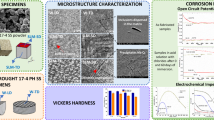Abstract
The effect of porosity––a common welding defect––on the fatigue crack growth rate (FCGR) in Ti–6Al–4V laser welds was investigated. The experimental results reveal that porosity was present in partial penetration welds over a narrow fusion zone (FZ) with martensite structure. The FCGR of the FZ was lower than that of the base plate. The fracture surface morphology of weld metal was much rougher as compared to that of the base plate. Randomly oriented martensite in the FZ led to local cleavage fracture along a preferred plane, thus, altering the crack growth direction significantly out of the primary crack plane. The zigzag crack path in the FZ resulted in a reduced FCGR at a given ΔK compared to the base plate. Besides, the porous weld showed a serration on the crack growth curve, and behaved the similar crack growth characteristics as the defect free one. SEM fractography revealed that the deflection of crack path around porosity together with local notch blunting as the crack tip pierced into porosity, balanced the increased FCGR for the occurrence of instant crack advance as the crack front reached the porosity at a low stress ratio. In contrast, the serration and drop in FCGR occurred sparingly at a high stress ratio as the crack front met the porosity.





Similar content being viewed by others
References
Thomas G, Ramachandra V, Nair MJ, Nagarajan KV, Vasudevan R (1992) Weld J 71:15s
Lancaster JF (1984) The physics of welding. Pergamon, Oxford, pp 269–290
Qi Huang G, Kullberg, Skoog H (1994) Optics Laser in Eng 20:3
Li Z, Gobbi SL, Norris I, Zolotovsky S, Richter KH (1997) J Mats Proc Tech 65:203
Thomas G, Ramachandra V, Nagarajan KV, Pant B, Sarkar BK, Vasudevan R (1989) Weld J 69:336s
Mazumder J, Steen WM (1980) Met Construct 12:423
Matsunawa A, Kim J, Katayama S (1997) ICALEO, Section-G, pp 73–82
Chen SJ, Devletian JH (1990) Weld J 69:319s
Chen SJ, Devletian JH (1982) Metall Trans 13A:865
Denney PE, Metzbower EA (1989) Weld J 68:342s
Yoder GR, Cooley LA, Crooker TW (1976) Metall Trans 8A:1937
Ravichandran KS (1990) Scripta Metall Mater 24:1275
Ravichandran KS, Dwarakadasa ES (1989) Scripta Metall 23:1685
Ravichandran KS, Dwarakadasa ES, Banerjee D (1991) Scripta Metall Mater 25:2115
Bache MR, Evans WJ, McElhone M (1997) Mater Sci Eng A 234–236:918
Evans WJ, Bache MR, McElhone M, Grabowski L (1997) Int J Fatigue 19:S177
Bache MR, Evans WJ (2001) Int J Fatigue 23:S319
Davidson DL, Lankford J (1984) Metall Trans 15A:1931
Irving PE, Beevers CJ (1974) Metall Trans 5:391
Yoder GR, Cooley LA, Crooker TW (1978) Metall Trans 9A:1413
Ogawa T, Tokaji K (1993) Fatigue Fract Eng Mater Struct 16:973
Fusion welding for aerospace applications, Aerospace material specification AMS-STD-2219A, May (1999)
Saxena A, Hudak SJ (1978) Int J Fracture 14:453
Tsay LW, Tsay CY (1997) Int J Fatigue 19:713
Shiue RK, Chang CT, Yang MC, Tsay LW (2004) Mat Sci Eng A364:101
Tsay LW, Yang MC, Chou FY, Shiue RK (2004) Mat Chem Phy 88:348
Shi YW, Chen BY, Zhang JX (1990) Eng Fract Mech 36:893
Beghini M, Bertini L, Vitale E (1994) Fatigue Fract Eng Mater Struct 17:1433
Kitsunai Y, Takana M, Yoshihisa E (1998) Metall Trans 29A:289
Nelson HG, Williams DP, Stein JE (1972) Metall Trans 3:469
Suresh S, Ritchie RO (1982) Metall Trans 13A:1627
Wang SH Muller C (1998) J Mat Sci 33:4509
Kamat SV, Eswaraprasad N (1992) Scripta Metall Mater 26:1713
Acknowledgements
The authors gratefully acknowledge the financial support of this study by National Science Council of Republic China (92-CS-7-019-002). We also appreciate Dr. Raghu V. Prakash, Department of Mechanical Engineering, Indian Institute of Technology, Madras for his valuable suggestions and comments.
Author information
Authors and Affiliations
Corresponding author
Rights and permissions
About this article
Cite this article
Tsay, L.W., Shan, YP., Chao, YH. et al. The influence of porosity on the fatigue crack growth behavior of Ti–6Al–4V laser welds. J Mater Sci 41, 7498–7505 (2006). https://doi.org/10.1007/s10853-006-0833-x
Received:
Accepted:
Published:
Issue Date:
DOI: https://doi.org/10.1007/s10853-006-0833-x




